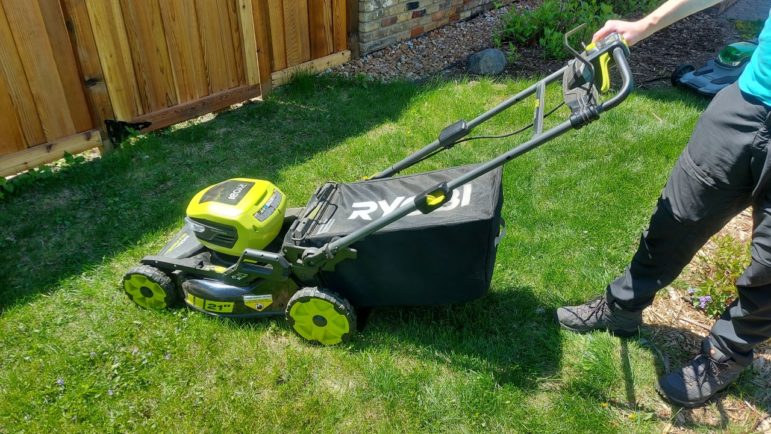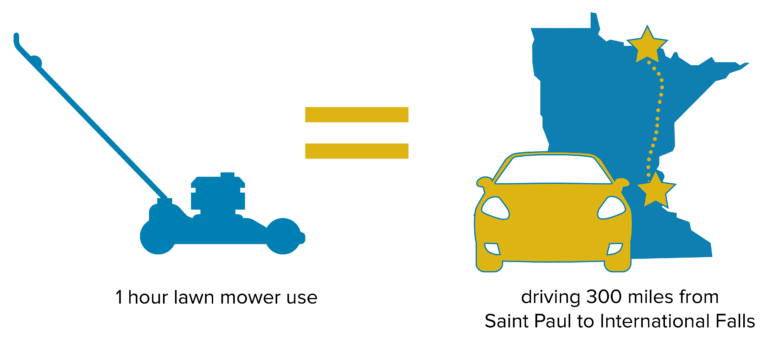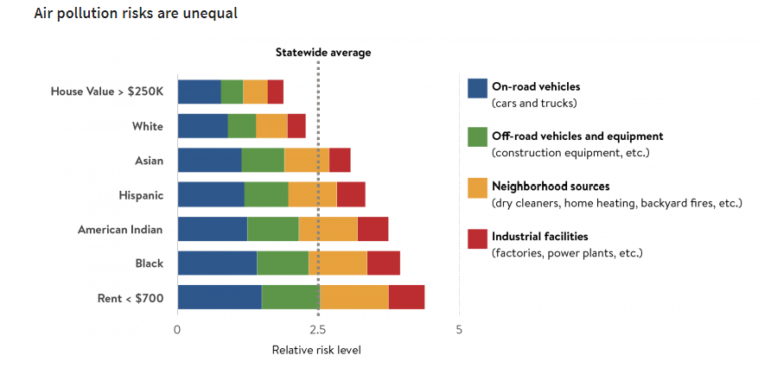
The smell of fresh cut grass and the roar of lawn mowers are synonymous with summer — not to mention the whir of leaf blowers, string trimmers, chain saws, and other yard care tools that keep parks, public spaces, and yards looking fresh.
Many Minnesotans are switching their gas-powered lawncare equipment to electric. They’re easier to maintain, much quieter to use, and they don’t emit harmful air pollutants. You’d be surprised at how much pollution small, handheld lawn equipment can emit!
Fresh Energy has worked more than thirty years to help Minnesota reach its carbon reduction goals. Part of the equation is electrifying tools and appliances that traditionally use fossil fuels, a process called “beneficial electrification” that is pivotal in decarbonizing our energy system. Consumers play a significant role in this process — they drive market trends and manufacturers take notice.
Electric lawn equipment is cleaner, easier to use, and better for the environment
Gas lawn mowers are dirty: An area ripe for “going electric” is the equipment we use for yard care. Currently, the majority of the lawn equipment used in the United States is powered by fossil fuel, and—while the machines themselves use a relatively small amount of it—their massive climate and emissions impacts far outweigh any benefits, especially when you consider that nearly 54 million Americans mow their lawns every weekend.
That adds up to nearly 800 million gallons of fossil fuel annually just for yard care, 17 million gallons of which get spilled in the process—more than all the oil spilled by the Exxon Valdez in the Gulf of Alaska in 1989. Spillage aside, research by the California Air Resources Board shows that using a fossil-fuel powered mower for just one hour emits as much pollution as driving 300 miles. That’s the distance from International Falls to St. Paul!

Gas lawn mower emit unhealthy pollutants: Because traditional yard care equipment burns fossil fuel to operate, it emits harmful gases like carbon monoxide, particulate matter, and nitrogen oxides. Those emissions do not only have climate impacts; they can also cause serious respiratory diseases and dramatically reduce the quality of the air we breathe, especially for kids, older adults, and people with lung or heart disease who are all at increased risk. In addition, the threats presented by air pollution fall hardest on Black and Indigenous Minnesotans and other communities of color.

Enter: Electric lawn mowers, electric string trimmers, and more!
Electric lawn mowers and other electric lawn equipment use less energy, don’t emit fumes, are quieter, require less maintenance, weigh less, store easier, and they always start. No more wrenching on that dreaded pull start! Going electric is a key way Minnesotans can reduce the number of harmful pollutants released into the air — and avoid waking the entire neighborhood when you want to mow your lawn at 8 a.m. on a Saturday morning or calling up a friend or mechanic to clean out the carburetor!
When it comes to purchasing an electric mower, keep in mind that choosing between corded and cordless options is mostly about preference. Corded mowers don’t require recharging, so they run longer than their cordless counterparts. But, if you want to be able to use the same batteries with other equipment, have a space where outside outlets are not accessible, or simply don’t want to mess with a cord, going cordless might be your best bet.
Electric lawn mowers are easier to maintain: Gas mowers require a lot of maintenance — oil changes, fresh gas, winterization, and annoying carburetor cleanings that eat up your entire weekend afternoon. In comparison, maintaining an electric lawn mower is a breeze. Starting it up is as simple as pressing a button, and maintaining it only requires keeping the batteries charge up. For winterization, simply bring the battery inside for storage and charge it three quarters of the way full. Check its charge level once or twice over the winter—but charge only if necessary. Other than that, Shift2Electric’s yard equipment expert Jukka Kukkonen says, “Just leave it be.” The benefit of going electric is that it’s far less maintenance than its gas-powered counterparts!
Electric lawn mowers are becoming very affordable: Worried that transitioning from gas-powered to electric lawn care appliances will come with a hefty price tag? Don’t be. Battery technology development has brought the price of electric yard equipment to parity with traditional equipment — especially when you compare the ongoing maintenance costs of purchasing gas, oil, and occasional tune-ups for your gas-powered lawn equipment. Plus, you could save even more by buying used. Hop onto Craigslist or Facebook Marketplace to see what’s available in your area. And, in some cases, your utility may even offer you an incentive or rebate for going electric — check with them too!
Communities are benefiting from switching to electric lawn equipment
The clean yard care revolution certainly isn’t exclusive to homeowners — businesses and places of worship are jumping on board the clean lawn care train too. In 2020, Twin Cities resident Michael Stoick attended a Shift2Electric clean lawn care webinar and learned of the massive climate and emissions impacts that result from fossil gas-powered lawn equipment. He left convinced that the church he attends, Macalester Plymouth United Church — which also houses a preschool — needed to ditch the gas.

Transitioning the church equipment to electric was a surprisingly quick process: one parishioner donated his electric mower and set things in motion. Although there were initially some concerns — battery charging logistics, ensuring the space is regularly cared for if a provider is no longer servicing it, costs — the St. Paul-based congregation is thrilled to have another practical opportunity to take care of the world around them and care for their community’s health in the process.
Stoick says, “Rather than outsourcing the work that needs to be done, we can use this [electric equipment] to bring it home and help people take ownership” of a space that they collectively use and enjoy. “It sets an example to the church,” he says, of how to care for each other and the city as a whole.
Looking for more resources on making the shift to electric with your everyday appliances? Head to our Go Electric page, where we compiled all our blog posts, electric product lists, and past webinars into one spot to help you identify the most practical ways to cut your dependence on fossil fuel and electrify your life — one appliance, vehicle, and tool at a time.
Select the right electric vehicle, mower, chainsaw, other lawn equipment, and snow blower for you
Click on the links below to view the many makes and models of electric vehicles, outdoor equipment, and more below. Each PDF provides product specifications, prices, and other helpful information so you can get the right one for your needs.
Electric Product Lists from American Lung Association, Shift2Electric, and Fresh Energy:
- U.S. Electric Vehicle (EV) Info List (Updated April 2025)
- Battery-Powered Electric Lawn Mower Info List (Updated March 2025)
- Corded Electric Lawn Mower Info List (Updated March 2025)
- Commercial Electric Lawn Mower Info List (Updated March 2025)
- Battery-Powered Electric Chainsaws, Hedge Trimmers, Leaf Blowers, Polesaws, and String Trimmers (Updated March 2025)
- Battery-Powered Electric Snow Blowers (Updated March 2025)
